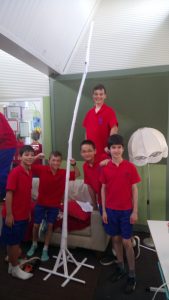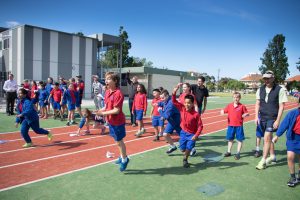At Port Melbourne Primary School, students and their families recently had a blast exploring the Victorian Maths Challenge (VMC).
As an introduction to the VMC, parents and other family members were first asked to think about how maths was taught in the past. Some grandparents recalled sitting in silence, in single desks writing out equations on paper. Some parents shared similar experiences, noting that they never got the chance to engage in fun, real-world tasks when doing maths at school. In contrast to these past learning experiences, the VMC offers participants the chance to engage in collaborative, hands-on and open-ended tasks. Not surprisingly then, it was with a lot of enthusiasm that the Port Melbourne Primary families took on the different challenges on offer.
 For the Eureka Challenge, students and their families created in depth plans after thoughtful discussions around what maths they could apply to beat the existing Eureka Tower record of 2.83 metres high. After talking about the importance of stability and balance, the participants decided to put more weight at the base of their towers to stabilise and strengthen them. They also considered the importance of perfect right angles on either side of their structures to ensure balance. Thinking about 3D shapes, they also decided triangular pyramids, cubes and cylinders would give strength to their towers.
For the Eureka Challenge, students and their families created in depth plans after thoughtful discussions around what maths they could apply to beat the existing Eureka Tower record of 2.83 metres high. After talking about the importance of stability and balance, the participants decided to put more weight at the base of their towers to stabilise and strengthen them. They also considered the importance of perfect right angles on either side of their structures to ensure balance. Thinking about 3D shapes, they also decided triangular pyramids, cubes and cylinders would give strength to their towers.
Before tackling the Paper Planes Challenge, students and their families discussed factors that impact a smooth flight. They talked about thrust – the forwards force generated when a paper plane is thrown (in a plane an engine generates thrust), gravity – the downwards force which pulls the paper plane towards the ground, drag – the force that slows planes down due to air resistance, and lift – the force that pulls the plane towards the sky (when the plane flies forward, the air that moves under the wings provides this upwards force). Following these discussions, the students and their families made their paper planes.
Students then thought about how they would measure the distances flown. They thought about using their feet, a measuring wheel, metre rulers and estimation. Most students estimated a large step was approximately a metre in length and then used this system to measure distances. The winning plane reached a whopping 16 metres – looks like there is a budding aerospace engineer at Port Melbourne Primary.
Have a look at the Gallery to see more of Port Melbourne Primary School’s maths adventures – you might get some ideas that will help you beat their records!